Blue perennial flowers reflect calm and speak serenity. The versatile color can create different effects in the garden. If you want to create a tranquil and relaxed atmosphere, plant blue flowers near places you like to unwind, such as patios or decks. You could also try using blue flowers as accents in an otherwise green garden.
Are you ready to destress your life and garden? Read on to learn about some of the most beautiful blue perennials in the world.

1. Blue Flax

Blue flax is native to England and the Alps.
©iStock.com/Marcasia
The delicate blue flax perennials are morning lovers and only open in the morning. They stay completely shut for the rest of the day.
Blue flax makes a beautiful addition to wildflower meadow mixes and is famous throughout the northern United States. Blooming throughout June and July, flax can tolerate some of the driest conditions. This makes them one of the most persistent blue perennial flowers in the wild.
Because they open so early in the morning, blue flax is a fantastic choice for moon gardens. They can also help carry the color blue through your garden when many other flowers have faded.
2. Bluets

Bluets have small, delicate flowers that are not bigger than a fingernail.
©iStock.com/Kyle Reynolds
When it’s time to sleep, bluets close their flowers. Every night they droop over, nodding their heads on a fine hair-like stem. When the morning comes, they burst open. Flies that resemble bumblebees, often called bee flies, are frequent morning visitors.
Their name bluet comes from the French word meaning “small blue.” These vibrant blue perennials have small basal leaves and four-petaled flowers. The flowers are also small, blue, and white at the center. Sometimes the center is yellow.
Look for wild bluets spreading across roadsides, lawns, and open fields. They’re native to southern Canada. Growing only 2 to 8 inches tall, you can find these blue perennial flowers bloom throughout April and July.
To thrive, they need partial shade and average moisture soil. They can do well and gravelly soils where other plants can’t thrive. Sometimes these flowers die back in the summer and then grow new rosettes during the fall.
3. Forget-Me-Nots
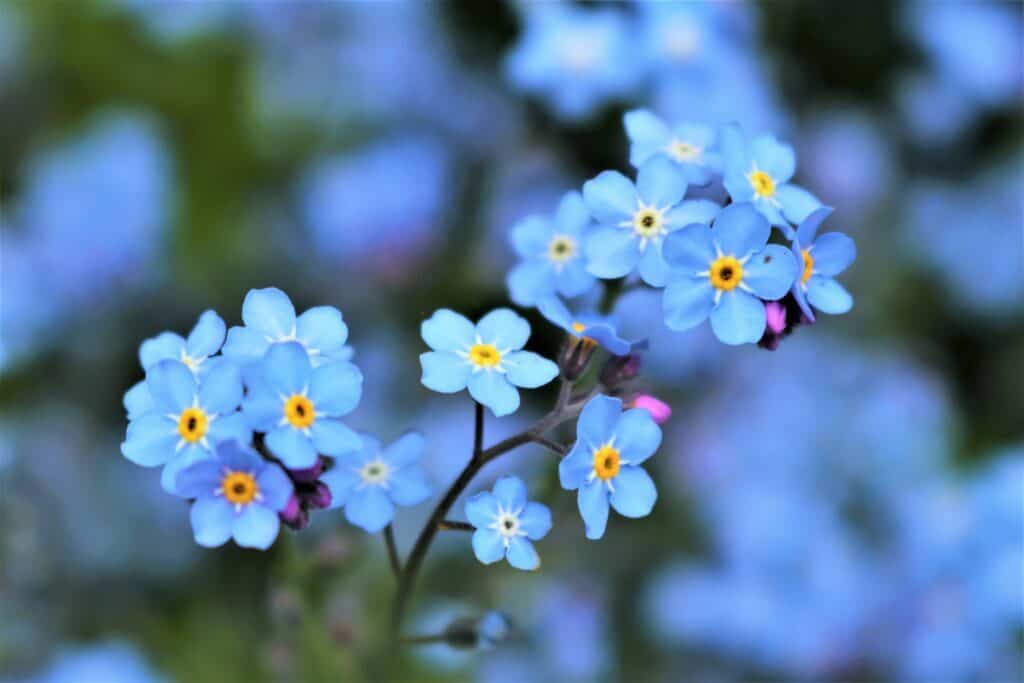
Forget-me-not flower blooms do not last long, but they are a bright and happy addition to any garden bed.
©iStock.com/Agnieszka Klimaszewska
Whether formal or wild, forget-me-nots are a welcome addition to any garden. There are two species you should be aware of. First, there’s Mytosis scorpioides, a perennial species. Second, there’s M. Sylvatica, an annual variety.
Both species are from Europe and belong to the garden scene. A lot of the other, forget-me-not species in the world are native to North America. However, the forget-me-nots that are native to North America aren’t frequently encountered in the wild.
If you’ve seen forget-me-nots in the wild, you probably were looking at Mytosis scorpioides, the perennial species. Mytosis is a Greek word meaning mouse ear. It refers to the small leaves.
The unforgettable small, light blue flowers have five petals with a yellow center. You can find forget-me-nots throughout wet meadows, woods, and stream sides. They’re popular among hikers in Canada and Europe.
4. Bottle Gentian
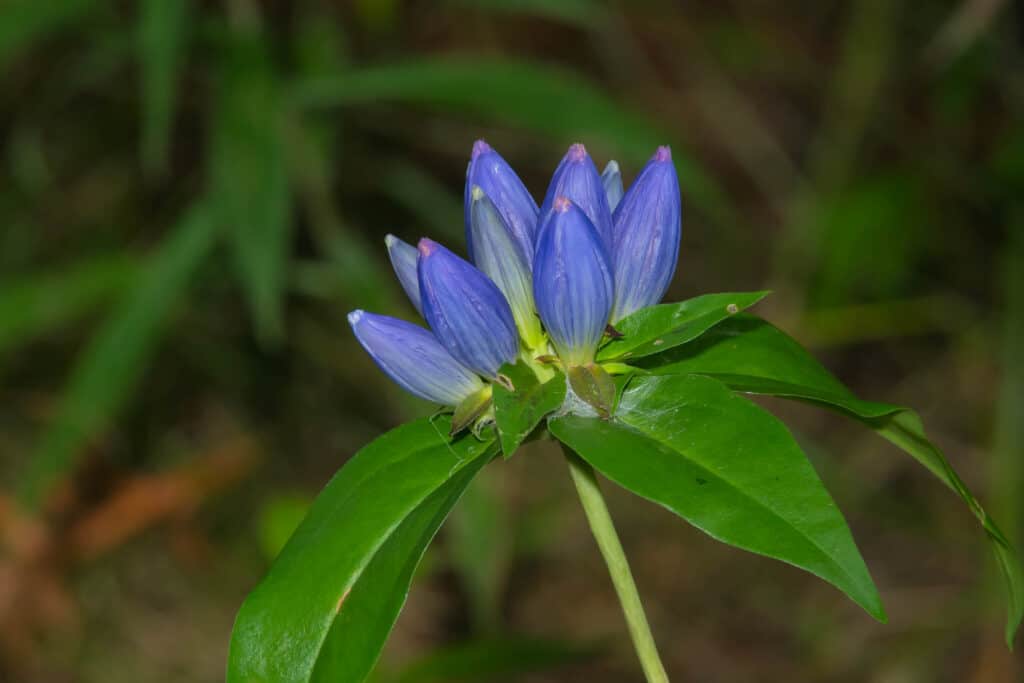
Bottled Gentian flowers bloom from late summer into early fall.
©iStock.com/PaulReevesPhotography
Deep blue blossoms that never seem to open fully give the bottle gentian its name. It looks like the flower is inside a bottle.
The unopened blossom has four petals that are fused at the base. The rest of the flower is tubular with long white stamens with blue anthers. This flower is pollinated by bees and other insects that can reach the nectar at the bottom of the tube. It grows 2 to 3 feet and blooms from mid-summer to early fall.
You can find this wildflower in the mountainous regions of North America. You’ll find it in open areas such as woods edges, prairies, and meadows. Look for it in states like Ohio, New York, and Pennsylvania. It’s also native to Ontario and Quebec in Canada.
5. Virginia Bluebells
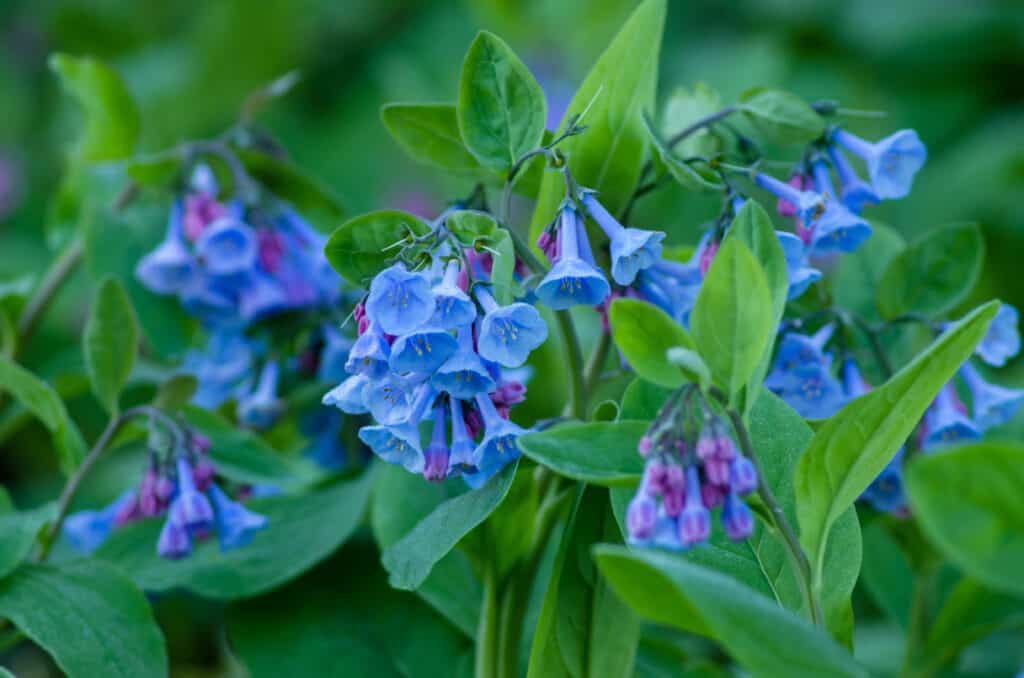
Wild Virginia Bluebells usually have blue flowers. However, on rare occasions, they may have white or pink flowers as well.
©iStock.com/Joshua Moore
Virginia bluebells (Mertensia virginica) are popular blue perennial flowers. The plant is native to the eastern United States, where it can be found in woods and along streams from New York to Florida and west to Illinois and Kansas.
The Virginia bluebells belong to the borage family (Boraginaceae). It gets its common name from its bell-shaped flowers, which are usually blue but can also be white or pink. The plant blooms in April and May.
After blooming, the flowers turn into seed capsules that burst open when they mature, releasing their seeds. Bluebells are a popular choice for gardens and wildflower meadows. They prefer partial shade and moist, well-drained soil.
During the 1800s, they were brought to England. It was there that a famous garden designer and landscaper, William Robinson, noticed their beauty. They’ve been popular ever since! If you’re looking for a showy spring wildflower for your garden, Virginia bluebells are a good option!
6. Blue-Eyed Grass
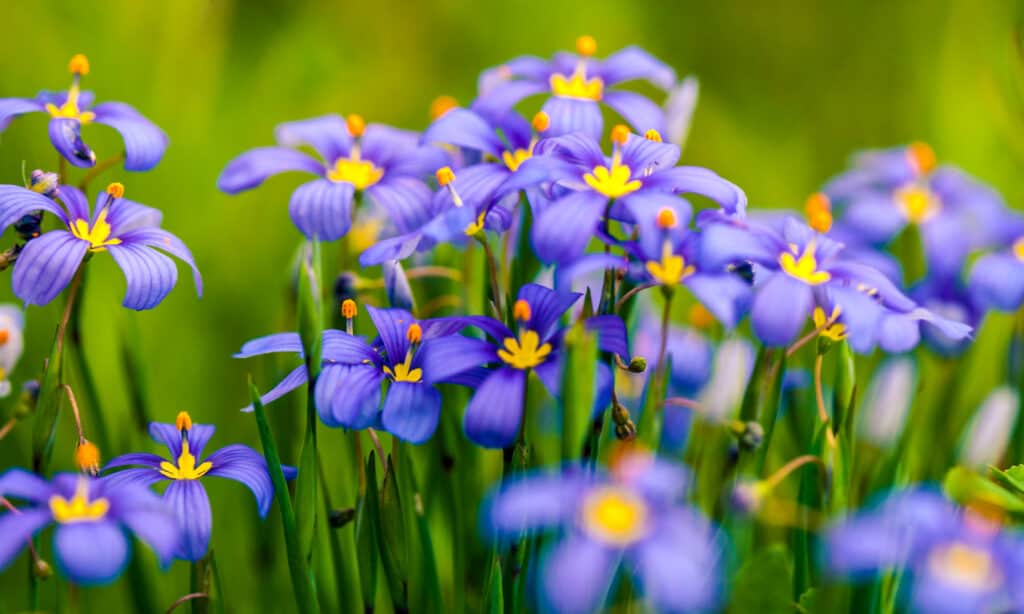
Many species of blue-eyed grass are endangered in the eastern United States.
©Moab Republic/Shutterstock.com
The leaves of this flower look like overgrown grass blades, and they open up directly from the ground! Blue-eyed grass is a striking perennial. The flowers feature a deep blue hue with yellow centers and six surrounding petals.
You can find blue-eyed grass throughout woods, roadsides, and meadows. Growing 6 to 12 inches in height, this perennial blooms through May and June.
It’s popular in the Eastern and Central United States. These blue perennial flowers are sometimes called the “Star of Bethlehem.” This is because the flowers somewhat resemble the shape of a star. They often will grow in large clumps and make for a great addition to any garden.
7. Blue Flag
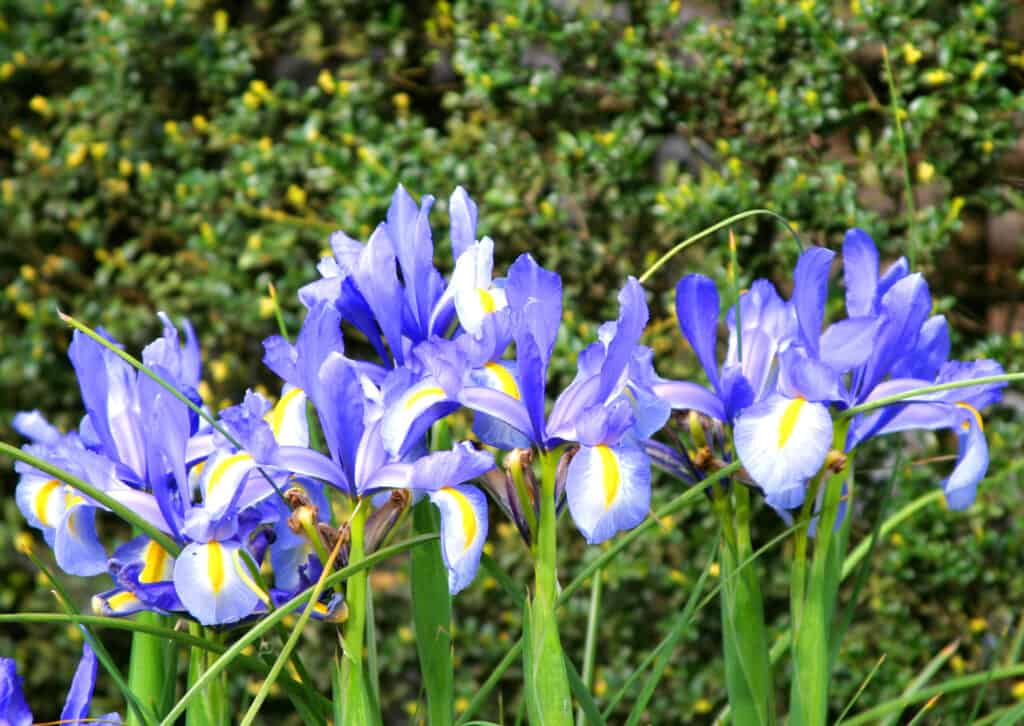
The roots and leaves of blue flag iris flowers are poisonous.
©iStock.com/LailaRberg
Iris is a Greek word that means “rainbows.” These flowers come in many different colors throughout their genus, but the blue flag is one of the most popular native irises. It’s a flower that adds to the rainbow effect of any garden.
True to its name, the petals have a striking blue color that sometimes turns into a full violet hue. This perennial grows best in wet areas, and the leaves are thin and sword-like. The flower stock is as tall as the leaves! The brilliant blue blooms have yellow stripes on their lower sepals.
Prevalent throughout Southern Canada and Minnesota, you’ll also find blue flags throughout Virginia. Since it can grow to be 2 to 3 ft tall, it’s hard to miss it when they bloom between May and July.
For the best growth, the blue flag needs full sun and high-moisture soil. Some of their favorite spots to take root include the side of a stream or the edge of a lake. You can find this plant thriving in swamps, marshes, lake edges, and wetlands.
Summary of 7 Blue Perennial Flowers
| Number | Blue Perennial Flowers |
|---|---|
| 1 | Blue Flax |
| 2 | Bluets |
| 3 | Forget-Me-Nots |
| 4 | Bottle Gentian |
| 5 | Virginia Bluebells |
| 6 | Blue-Eyed Grass |
| 7 | Blue Flag |
The photo featured at the top of this post is © iStock.com/Joshua Moore
Sources
- Gardening.org, Available here: https://gardening.org/14-blue-perennials-youll-want-in-your-garden/
- University of Florida Gardening Solutions, Available here: https://gardeningsolutions.ifas.ufl.edu/plants/ornamentals/blue-flowers.html
- North Dakota State University, Available here: https://www.ag.ndsu.edu/yardandgardenreport/2020-11-01/new-blue-perennials
Thank you for reading! Have some feedback for us? Contact the AZ Animals editorial team.






